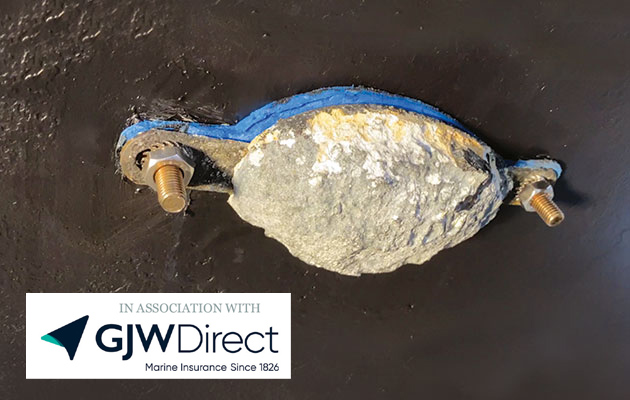Prepare properly for getting back afloat, and you and your boat will be ready for a trouble-free season, Rubicon 3 Adventure’s John Manners shares his boat checklist
Boat checklist: 27 checks for the start of the season
With the days beginning to lengthen, February to April is the time to be getting your yacht ready for the season ahead, writes John Manners.
Preparation now is the key to a stress-free summer on the water.
Pre-season checks and maintenance should be a rewarding process, in which you learn more about your boat, develop some extra skills and see the rewards of your efforts.
Getting ready for the season can be divided into three distinct phases. Pre-launch (assuming your yacht is on the hard), post-launch checks, and a shake-down sail.
The pre-launch checks we cover below are the most critical to get done because the cost and inconvenience of having to lift a yacht back out again can be high.

Be ready to check all through hulls while in the sling. Credit: Alamy Stock Photo
Your hull, including your keel, skeg/and rudder, needs a good, thorough check over. Any issues that need fixing can be time consuming and GRP work needs suitable temperatures.
Once your yacht is launched, you’ll want to do a full systems check.

John Manners is chief engineer at the Marine Engineers for Rubicon 3 Adventure sailing (www.rubicon3 adventure.com). He served 24 years in the Royal Navy, finishing as a Chief Petty Officer. Credit: Rubicon 3 Adventures
You really should have your own specific boat checklist, so that you can be thorough and time efficient.
You can use our lists below as a good starting point if you don’t have one.
There’s always a surprising amount to check, so put a full day aside and ensure you find the issues now, not when you’re out on the water.
Finally, a boat can only really be signed off as season-ready once it has had a sail.
This is when the boat comes alive and all the stresses and strains will reveal if there are any as-of-yet undiscovered issues.
If there are any problems then a good day sail and overnight anchor should weed them out and, while any issues can be frustrating, at least they’ve been found before your first proper sail of the season.
Finally, when you finish this season, while they’re still fresh in your mind, make a list of any issues to fix before the next season and get the yacht properly winterised.
Boat checklist: On the hard

Check anodes and if electrically bonded, check it is working. Credit: Rubicon 3 Adventures
- Check hull for any cracks, delamination, corrosion (if metal), and impact damage and get repaired.
- Scrape test all through hull fittings to expose any corrosion. Exercise and grease the valves.
- The propeller should be tight and blade bearings smooth when you rotate them.
- Ensure the P-bracket (if you have one) is secure and there is no play in the bearings here or in the stern tube. If you have a sail drive, check the diaphragm and gaiter.
- Check your rudder bearings are in good shape.
- Give the hull a thorough anti-foul and change all the anodes.
- Clean any keel coolers.
- Make sure your log is clean and rotates freely.
- Protect your prop with one of the many products available.
- If you have a bow thruster, make sure it is operational and has been serviced.
Continues below…
We Tested The Best Inflatable Lifejacket and PFD’s for Boating and Sailing
We all have lifejackets on board, but do you know what yours is actually like to use? We test 10…
How to: check and change an anode
Promotional feature in association with GJW Direct. Keeping your anodes in good order prevents serious damage on board, says Rubicon…
Shakedown skills and drills for the start of the season
After a long break the skipper may need to knock the rust off a few skills, as well as getting…
Marine gas safety: checks for peace of mind on board
Surveyor Ben Sutcliffe-Davies shares the simple checks you should do on board to make sure your gas installation is safe
Boat checklist: Post launch checks

A radio check (not on Ch 16) is appropriate for the start of the season. Credit: Rubicon 3 Adventures
- Check all through-hull fittings for leaks before you are released from the slings.
- Fire up your engine, heating and generator if you have one and give them all a good service.
- If you have a battery tester, check each battery individually. If not, companies such as Barden UK will often test your batteries free of charge.
- Get your marine gas system tested and signed off (this is not something to skimp on).
- Check your fire extinguishers are in date, have pressure and are in good condition.
- Make sure your liferaft and lifejackets have been serviced and your hydrostatic release units (if you use them) are in date, along with your flares.
- Check your lee cloths are in good condition and well attached
- Make sure hatches and other slippery surfaces on deck have anti-slip tape on them in good condition.
- Make sure jackstays are in good condition and tight.

Boat checklist: Getting an annual gas inspection is a check that should not be skipped. Credit: Graham Snook/Yachting Monthly
- Guard wires should be tight and the lashings in good condition.
- Leak test your hatches and portlights. If they do leak, it’s not often that big a job to re-bed them or replace seals, but a damp boat is miserable.
- Fire up the electronics. You should see a GPS position within 10-20 seconds and if you have an AIS transponder, you should see yourself on a website such as Marinetraffic.com in less than 10 minutes.
- Make sure the charts are reasonably up to date – and do carry paper ones, even if they are of a fairly small scale. You’ll also want this year’s almanac for tidal and marina information.
- Carry out a VHF radio check to make sure it is working.
- You’ll also want to check your tools (which can all too easily get rusty and inoperable) and your emergency spares like spare impeller, oil, coolant and wooden bungs.
- Carry a small first aid kit, and check it’s in date and complete.
- Now the yacht is in the water, you can also get a rigger to give your boat rig the once over and ask them to check your furling system is working nicely and been serviced if required.

An emergency kit can rust and become inoperable. Make sure to check it before going sailing. Credit: Graham Snook/Yachting Monthly
Boat checklist: Shake down sail

Practice key manoeuvres on your first sail of the season. Credit: Richard Langdon
It’s time to get a couple of friends and family down to the boat and go for a sail.
You need to try and use every function on the boat, so pick a nice day when you can get all the sail up, the oven on, the anchor out and the nav and anchor lights used.
All going well, everything is ship shape, but if not, better to find out now.
Your marina handling skills (and confidence) may be a bit low so go easy on yourself (and you crew!) and give yourself time to hone your skills.

Make a cuppa and test your domestic systems. Credit: Richard Langdon
If everything is working fine, this sail is also a good opportunity to do a couple of man overboard drills, picking up a mooring buoy, getting the pole up and doing some navigation and tidal calculations.
Also rehearse making a MAYDAY call, fighting a fire and dealing with a CO alarm.
Faded skills affect everyone, so recognise that you do need to keep on practising these skills.
Enjoyed reading this article?
A subscription to Yachting Monthly magazine costs around 40% less than the cover price.
Print and digital editions are available through Magazines Direct – where you can also find the latest deals.
YM is packed with information to help you get the most from your time on the water.
-
-
- Take your seamanship to the next level with tips, advice and skills from our experts
- Impartial in-depth reviews of the latest yachts and equipment
- Cruising guides to help you reach those dream destinations
-
Follow us on Facebook, Twitter and Instagram.








